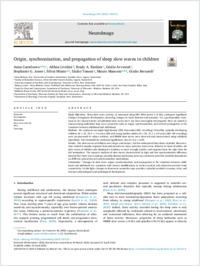Origin, synchronization, and propagation of sleep slow waves in children
- Castelnovo, Anna ORCID Sleep Medicine Unit, Neurocenter of Southern Switzerland, Ospedale Civico, Lugano, Switzerland - Faculty of Biomedical Sciences, Università della Svizzera italiana, Switzerland - University Hospital of Psychiatry and Psychotherapy, University of Bern, Switzerland
- Lividini, Althea Epilepsy Center - Sleep Medicine Center, Childhood and Adolescence Neuropsychiatry Unit, ASST SS. Paolo e Carlo, San Paolo Hospital, Milan, Italy
- Riedner, Brady A. Center for Sleep and Consciousness, Department of Psychiatry, University of Wisconsin - Madison, USA
- Avvenuti, Giulia MoMiLab Research Unit, IMT School for Advanced Studies Lucca, Italy
- Jones, Stephanie G. Department of Psychiatry, Wisconsin Institute for Sleep and Consciousness, University of Wisconsin-Madison , USA
- Miano, Silvia ORCID Sleep Medicine Unit, Neurocenter of Southern Switzerland, Ospedale Civico, Lugano, Switzerland - Faculty of Biomedical Sciences, Università della Svizzera italiana, Switzerland
- Tononi, Giulio Department of Psychiatry, Wisconsin Institute for Sleep and Consciousness, University of Wisconsin-Madison , USA
- Manconi, Mauro ORCID Sleep Medicine Unit, Neurocenter of Southern Switzerland, Ospedale Civico, Lugano, Switzerland - Faculty of Biomedical Sciences, Università della Svizzera italiana, Switzerland - Department of Neurology, University Hospital, Inselspital, Bern, Switzerland
- Bernardi, Giulio MoMiLab Research Unit, IMT School for Advanced Studies Lucca, Italy
- 2023
Published in:
- NeuroImage. - 2023, vol. 274, p. 120133
English
Study Objectives: Sleep slow wave activity, as measured using EEG delta power ( < 4 Hz), undergoes significant changes throughout development, mirroring changes in brain function and anatomy. Yet, age-dependent varia- tions in the characteristics of individual slow waves have not been thoroughly investigated. Here we aimed at characterizing individual slow wave properties such as origin, synchronization, and cortical propagation at the transition between childhood and adulthood. Methods: We analyzed overnight high-density (256 electrodes) EEG recordings of healthy typically developing children ( N = 21, 10.3 ± 1.5 years old) and young healthy adults ( N = 18, 31.1 ± 4.4 years old). All recordings were preprocessed to reduce artifacts, and NREM slow waves were detected and characterized using validated algorithms. The threshold for statistical significance was set at p = 0.05. Results: The slow waves of children were larger and steeper, but less widespread than those of adults. Moreover, they tended to mainly originate from and spread over more posterior brain areas. Relative to those of adults, the slow waves of children also displayed a tendency to more strongly involve and originate from the right than the left hemisphere. The separate analysis of slow waves characterized by high and low synchronization efficiency showed that these waves undergo partially distinct maturation patterns, consistent with their possible dependence on different generation and synchronization mechanisms. Conclusions: Changes in slow wave origin, synchronization, and propagation at the transition between child- hood and adulthood are consistent with known modifications in cortico-cortical and subcortico-cortical brain connectivity. In this light, changes in slow-wave properties may provide a valuable yardstick to assess, track, and interpret physiological and pathological development.
- Collections
- Language
-
- English
- Classification
- Medicine
- License
- Open access status
- gold
- Identifiers
-
- DOI 10.1016/j.neuroimage.2023.120133
- ARK ark:/12658/srd1331176
- Persistent URL
- https://n2t.net/ark:/12658/srd1331176
Statistics
Document views: 77
File downloads:
- Castelnovo_2023_Elsevier_NeuroImage_Origin, synchronization: 37
